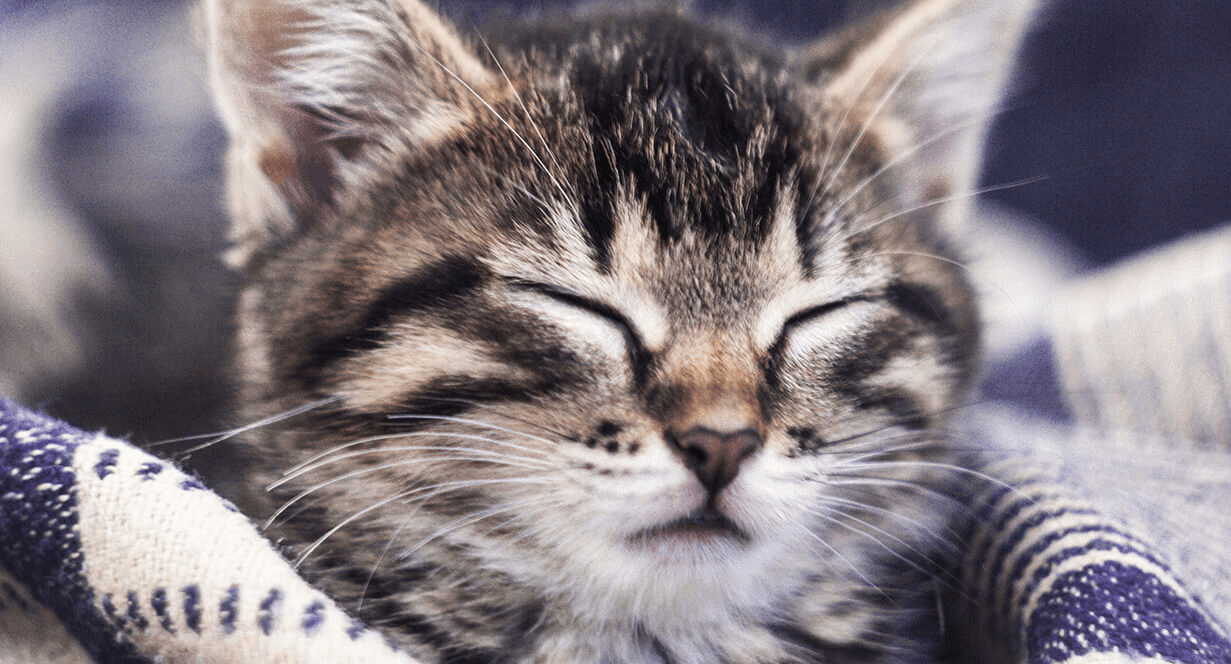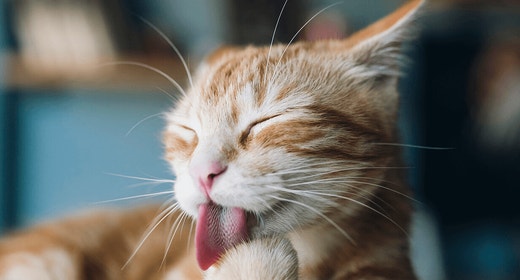

Most cats spend a considerable amount of time grooming their coats. As they do so, their hair is swallowed and may build up over time in their stomach. If the hairball doesn’t pass from the stomach, the cat will attempt to eliminate it by coughing or gagging.
Many cats have a hairball at some point in their life, but some cats, such as long-haired cats and cats that groom excessively, are especially prone to hairballs. In hairball-prone cats, frequent brushing can help reduce the amount of hair that is ingested, thereby reducing the risk of hairball formation. Feeding a special diet designed to decrease the likelihood of developing a hairball may also help.
Diet can be important in hairball relief for several reasons. The fiber combination of powdered cellulose and beet pulp in IAMS™ hairball formulas helps move hair through the digestive tract. IAMS research has shown that cats fed IAMS ProActive Health™ Adult Hairball Care pass 80% more hair in their feces than cats fed a leading premium dry cat food. By helping ingested hair to be passed from the digestive tract, IAMS hairball formulas help reduce the opportunities for hairballs to form. This fiber blend also includes a moderately fermentable component to promote intestinal health. High-quality, animal-based protein and fat, found in IAMS hairball formulas, provide important nutrients for skin and coat health. Maintaining skin and coat health may reduce the risk of excessive shedding, ingestion of hair from grooming, and, consequently, hairball formation.
Overweight cats have special nutritional needs in order to promote weight loss or weight management. Likewise, senior cats have special nutritional needs that are better met through a diet designed specifically for them. If an overweight or senior cat has problems with hairballs, feeding an IAMS hairball formula for indoor or senior (age 7+) cats is a great choice.
Yes. Mixing other foods with IAMS hairball formulas may compromise the effectiveness of this diet by diluting the nutrients that help reduce the risk of hairball formation. Switching between IAMS hairball formulas and another cat food may also decrease the benefit of feeding this diet.


An upset stomach is more common in cats than you might think. But how can you tell if it's a serious problem?
Every cat owner recognizes the warning signs of an upset feline stomach: the mournful meow, gagging, and heaving retch. But in a flash, the cat seems to snap back to good health while you're left scrubbing the carpet.
The scenario is a familiar one for Cynthia Bowen of Cleveland, Ohio. As the owner of four Maine Coons, Bowen has cleaned her share of messes. 'It would happen every couple of months or so,' she says. 'Otherwise, they were perfectly healthy.'
Although it's not a pleasant subject, vomiting is something cats seem to do almost on cue. Many cat owners accept this as a natural part of owning a pet, but it doesn't have to be that way. Knowing what triggers an upset stomach and what you can do about it will make for a better relationship with your cat.
Repeated cat vomiting should never be ignored because it can lead to dehydration. But, because vomiting is common in cats, how do you know what's normal? 'A general guideline is that if the cat is vomiting one to three times a month, we consider this 'normal,'' says Dr. William Folger, a DVM from Houston.
He considers it serious if the vomiting occurs twice daily for two or three days. If your cat stops eating, seems to have stomach pain, or retches continuously, or if there's blood in the vomit, take her to a veterinarian. And, as always, if you're suspicious that a lingering problem could be harmful to your pet, call your veterinarian. A visit to the office can help relieve your cat's discomfort and your worries as well.
Many owners attribute their cat's vomiting to hairballs, but that's not the only culprit. 'It's careless to assume that most cases of vomiting in cats are due to hairballs,' says Dr. Folger. Two other frequent causes of an upset stomach are:
Eating too fast. Cats sometimes eat too much, too fast. When the stomach wall expands too quickly, a signal is sent to the brain to cause regurgitation. In these cases, the mess on your floor is from regurgitation, not actual vomiting. When a cat regurgitates, he brings up fluid and food from his esophagus by opening his mouth–unlike vomiting, where there's gagging and retching. Regurgitated food is still formed, and may smell fermented. 'Cats that eat too quickly because they are gluttonous or stressed by food bowl competition can regurgitate right after eating,' says Dr. Sara Stephens, a DVM from Montana. But don't assume regurgitation is always a case of eating too fast. It could be caused by esophageal problems, obstruction of the digestive tract, hairballs, or dehydration. If you've forced your cat to eat slowly and he still has problems, contact a veterinarian.
Curiosity. Grass, carpet, and toilet paper are just a few things cats may digest and later vomit. The vomiting is a protective mechanism–nature's way of cleansing your cat’s system. Sometimes, though, curiosity can lead to more serious problems. String, toy parts, and feathers are favorites of playful felines and can lodge in the stomach or intestine, causing repeated vomiting and severe distress. If your cat exhibits these symptoms, take her to a veterinarian immediately; surgery is often necessary to remove the object.
Often, owners accept their pet's vomiting as a natural part of their behavior, but just because cats seem to have more than their fair share of tummy troubles doesn't mean you have to sit idly by.
One simple preventative measure is to get your fast-eating cat to slow down or to simply eat less. Stephens recommends smaller portions, elevating your cat's food dish slightly, or putting an object, such as a ball, into the dish. The cat will be forced to eat around the ball, and thus her intake will be slowed. If you do this, make sure the ball isn't small enough to swallow. And you may need to feed cats in a multiple-cat household at different times and places to reduce competitive eating.
If simple solutions don't work, watch your cat's eating behavior and reactions. Bowen, for example, tried changing her cats' diets. 'Since switching to IAMS®, they rarely throw up,' Bowen says.
'Usually, when you change to a higher-quality diet, there is no problem,' Stephens says. Here are some tips for helping make sure your cat's change is as successful and comfortable as possible:
Go slowly. Make the transition gradually to allow your cat time to adjust. 'Make sure the cat eats something every day,' Stephens advises. 'A cat that quits eating suddenly can develop liver problems.'
Measure up. How much should you feed? Your cat's age, sex, breed, activity level, and overall health need to be taken into consideration. Talk with your veterinarian, then read the manufacturer's recommendations. Premium foods like IAMS cat foods are more nutrient-dense than many non-premium diets, so don't be surprised if the recommended amounts seem low.
Pay attention. Beyond careful measuring, also regularly weigh your cat and adjust the feeding amount accordingly after switching to a premium food. Your cat may appear happy if you overfeed him. But over time, he may become overweight. Tummy troubles can be in the past with your veterinarian’s help and a little effort on your part.